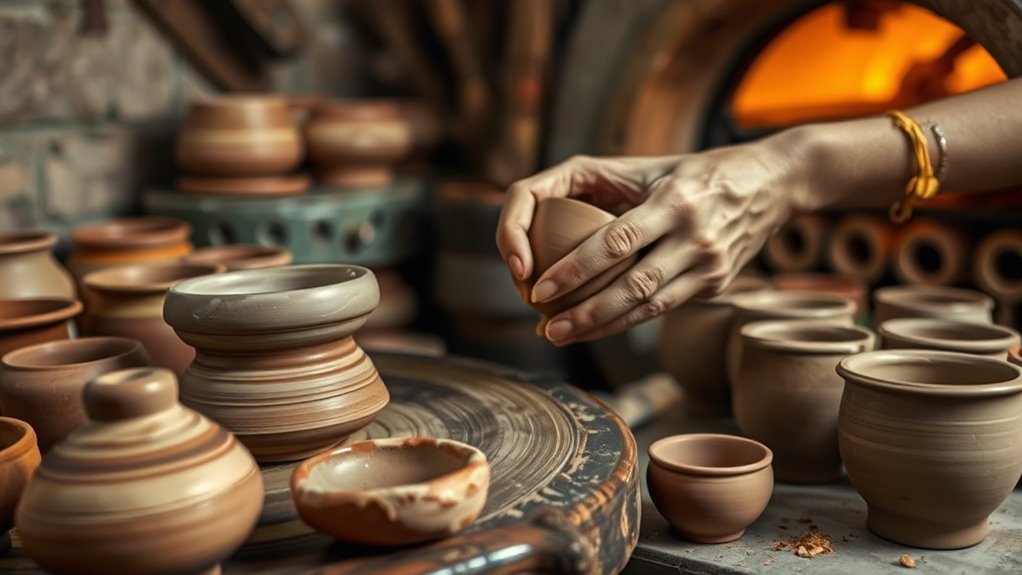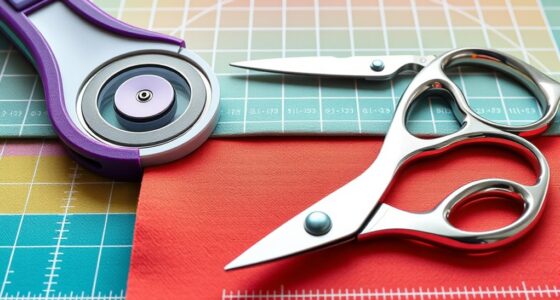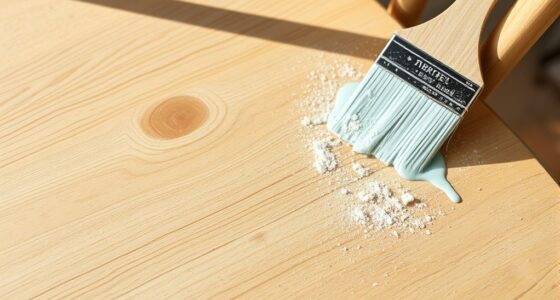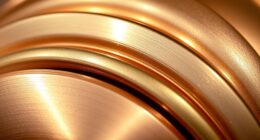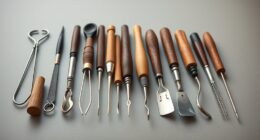To start with DIY pottery, you’ll want to know about clay types like earthenware, stoneware, and porcelain, each with unique properties and handling needs. Firing methods vary from electric kilns for consistent results, to raku for artistic finishes, and cone firing for precision. Exploring these options helps you choose the right combination for your projects. Keep exploring, and you’ll discover how to perfect your pottery techniques step-by-step.
Key Takeaways
- Understand the differences between earthenware, stoneware, and porcelain to select the right clay for your project.
- Properly prepare clay through wedging and kneading to ensure consistency and prevent defects during shaping.
- Choose appropriate firing methods like electric kiln, raku, or cone firing based on your desired finish and project type.
- Electric kilns offer controlled, uniform firing ideal for most clay types and glazing techniques.
- Explore alternative firing techniques such as pit or soda firing for unique surface textures and artistic effects.
Understanding Different Types of Clay
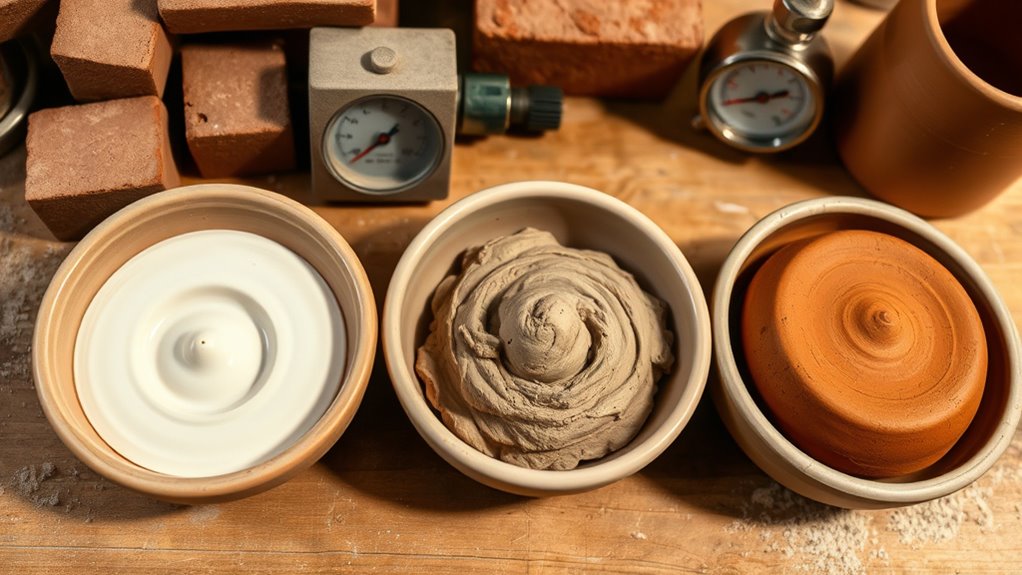
Have you ever wondered what makes each type of clay distinctive? Understanding different clay types starts with knowing how they respond to hand building techniques and clay preparation methods. Earthenware clay is porous and ideal for beginners, needing little preparation. Stoneware offers durability and a smooth finish, often requiring specific moisture levels and wedging to eliminate air pockets. Porcelain is fine and refined, demanding careful clay preparation to achieve its delicate texture. Each clay type behaves differently during shaping—some are more forgiving, while others need careful handling. Proper clay preparation methods, like wedging and kneading, ensure consistent texture and moisture content. Recognizing these differences helps you select the right clay for your project and master essential hand building techniques effectively.
Exploring Various Firing Techniques
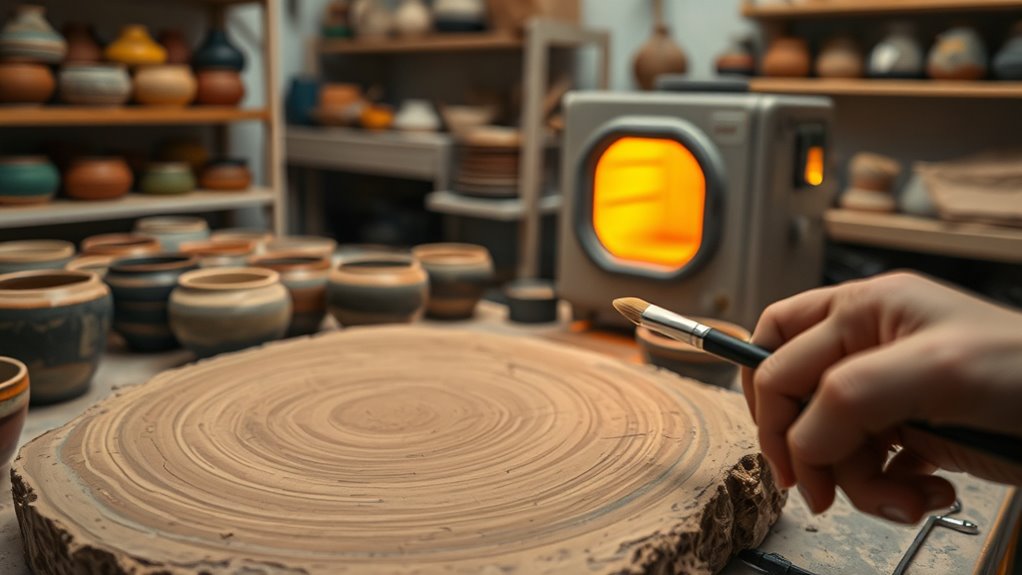
After preparing your clay and mastering hand-building techniques, the next step is to understand how firing transforms your pottery. Different firing methods affect the final look, durability, and glaze effects. For example, electric kilns provide consistent temperatures, ideal for glaze application techniques, while raku firing offers unpredictable, artistic results. Here’s a quick comparison:
| Firing Method | Key Features |
|---|---|
| Electric kiln | Controlled, clean, suitable for glazes |
| Raku | Rapid, unpredictable, unique finishes |
| Cone firing | Precise temperature control |
| Pit firing | Primitive, rustic look |
| Soda firing | Glossy, textured surface |
Always follow kiln safety procedures to prevent accidents. Understanding these techniques helps you choose the right method for your desired outcome. GMC tuning techniques can also be tailored to optimize performance, just as firing methods are selected for specific aesthetic and functional results.
Frequently Asked Questions
How Do I Choose the Right Clay for Beginners?
To choose the right clay for beginners, start with a smooth, easy-to-handle clay like earthenware or stoneware. Look at clay texture comparison to find a soft, workable option. Popular beginner clay brands include Amaco and Laguna, known for reliable quality. These brands offer consistent, beginner-friendly clays that are forgiving and simple to work with, helping you build confidence and develop your skills quickly.
What Safety Precautions Are Needed During Firing?
Did you know that improper kiln use can cause serious injuries? During firing, always wear heat-resistant gloves, eye protection, and a dust mask to guarantee firing safety. Keep the kiln in a well-ventilated area and never leave it unattended. Follow all kiln precautions, like checking for cracks and proper wiring. These steps help prevent accidents and ensure your pottery journey remains safe and enjoyable.
Can I Recycle Leftover Clay Safely?
You can recycle leftover clay safely by storing it properly in an airtight container to prevent it from drying out. Always guarantee clay recycling is done in a well-ventilated area to avoid inhaling dust. Before reusing, wedge the leftover clay thoroughly to remove air bubbles and ensure even consistency. This practice helps maintain leftover clay safety and minimizes waste, making your pottery projects more sustainable and enjoyable.
How Do Temperature Changes Affect Clay During Firing?
A change in temperature can really throw a wrench in your pottery process. When firing, uneven temperature shifts cause stress due to thermal expansion differences between clay and glaze. This can lead to cracks or glaze defects. To avoid this, control firing temperature carefully, ensuring glaze compatibility and consistent heat. Keep an eye on thermal expansion properties, so your piece remains sturdy and beautifully finished, avoiding any surprises in the kiln.
What Tools Are Essential for Basic Pottery Shaping?
You need crucial hand tools like a pottery rib, needle tool, and wooden modeling tools for basic pottery shaping. These tools help you refine your pottery shaping techniques, control the clay’s form, and add details. A wire cutter is also essential for slicing clay from the block. With these tools, you can confidently create and shape your pottery, ensuring clean lines and smooth surfaces for your project.
Conclusion
Just as clay transforms through different stages, your creativity evolves with each technique and material you explore. Embrace the journey, knowing that every firing and every type of clay holds a unique story—like a seed waiting to bloom. Keep experimenting and learning, for your art is a reflection of growth and patience. In this way, your pottery becomes a symbol of your own transformation, shaping not just clay, but your skills and confidence too.

